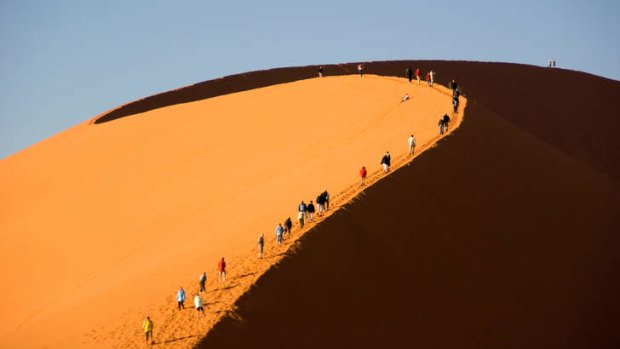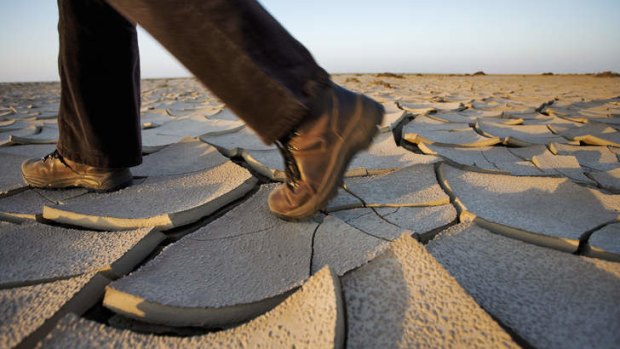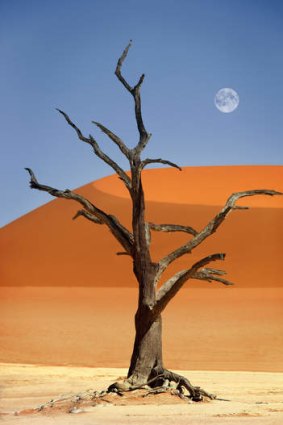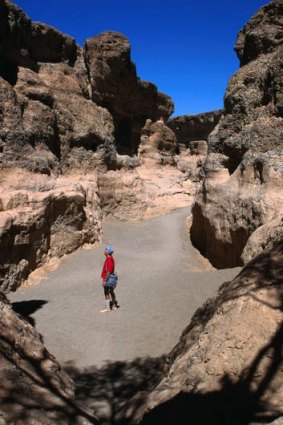
Dust to dust: climbing Dune 45.Credit: Alamy
For all the desert's stark beauty, Lance Richardson can't stop thinking about water.
Dehydration is unimaginable when you have easy access to water, like contemplating starvation after stuffing your face at a banquet. Comforted by the modern convenience of taps, for example, medical symptoms such as headaches, dizziness and irrational behaviour have the insubstantial reality of a rumour.
Concentrate on your lips and you can begin to gain a sense of how it might feel, though. Lips are a focal point for what happens to the whole body when it begins to dry out: this tiny patch of skin turns to dust, a sandstone cleft leading into a desert cave.

Mid-40s heat cracks the earth.Credit: Corbis
I am standing in Solitaire, a small junction in the middle of the Khomas Region of central Namibia, home to innumerable cactuses, stripped cars, and a sad-looking petrol pump. Something has gone terribly wrong. At Windhoek Airport I discovered that my Mastercard didn't work, the ATMs siding exclusively with Visa. No matter, I figured, there would be other opportunities, but it didn't really pan out that way. Now I'm on the edge of a seemingly infinite desert, with little more than a cracked tongue, half a litre of water, and the fluttery beginnings of a shoplifting fantasy.
"Do you take American dollars?" I ask the attendant in the small general store.
She looks appalled.

A camel thorn tree.Credit: Getty Images
"Well, do you take credit card?" I continue, eyeing off the plastic bottles of water.
She nods brusquely, although the shop's ATM, a small spaceship amid a junkyard of African curios, is covered in more of those hateful Visa signs. I take a deep breath and hand over my lifeline; then, while the machine deliberates, I judge the running distance to the truck and imagine life as a fugitive in the Namib Desert. Could I do it?
Dust flavours the air here and coats everything in a patina of grime. Cars shudder along unsealed roads and leave a trail of smoke as though they're on fire or disintegrating before your very eyes. The landscape is wide swatches of single colours - blue, yellow, red - that destroy all sense of distances and time, so you are driving and going nowhere, or merely slouching into oblivion. I have come here to camp, which feels appropriately transient for a place in endless states of erasure. But first: that question of water. The machine beeps, regurgitating paper. The woman narrows her eyes. Then she hands over a pen with an impatient wave of the hand: sign here, stupid man. With a valuable lesson learnt, I've been granted the liquid means to stave off death for another few days.

Tsauchab River-carved canyons.Credit: Getty Images
Even then, water is rarely far from my mind. The Tsauchab River, beginning in the southern Naukluft Mountains, is what is known as an "ephemeral stream", meaning it exists only in the rare instances of desert rain. While the Tsauchab may be an elusive sight, its effects have become legend: the ghostly salt pan of Sossusvlei, which fills up as a desert lake; Sesriem Canyon, carved by the river over centuries; and Deadvlei, strangest of all with its black, twisted trees and surrounding walls of sand. Devoid of moisture, this place is defined by it anyway.
The next day I wake at 4am, already coated in dust from evening winds blowing through the tent flaps. Within an hour I'm in a traffic queue at Sesriem gate, waiting for the Namib-Naukluft Park to open. Rounding out the trifecta of challenges here is the heat; it has become something of a rite of passage for visitors to climb Dune 45 before the sun turns the sand into a shimmering hotplate.
The Namib-Naukluft Park features some of the tallest dunes in the world, including the 325-metre Big Daddy. As sand blows east from the Atlantic Ocean, it collects in graceful mounds, the iron content oxidising and turning everything a rich apricot. Dune 45 is, unsurprisingly, 45 kilometres from the Sesriem gate, and when I reach it a horde of people is already climbing its 170-metre spine to watch the sunrise. It's a little incongruous to be confronted by so many visitors this early in the morning; pushing further on and facing away into the dunes restores a sense of solitude. The light rolls over the plains and shadows stretch to breaking point, fading on the ground like patches of damp.
Within hours temperatures have soared, but I am adamant about walking to the Tsauchab's most famous creation, the "dead marsh", or Deadvlei. Unlike Sossusvlei, which attracts flamingos when filled with water, this salt pan has long since declined as a place of refuge in the desert. Hundreds of years ago the river flooded the area, allowing camel thorn trees to take root in the sand. When it stopped flowing, however, the ground cracked into dramatic white plates and the trees seared black beneath the unrelenting sun. The result is something like an abstract painting, other-worldly and baffling. In The Cell, Hollywood used Deadvlei to represent the mental landscape of a serial killer. Jennifer Lopez wandered around it in a daze. Walking into the gnarled grove, I find myself doing something similar. All signs of life quickly fall away: the springboks, the hardy shrubs, the beetles with legs long enough to hoist their abdomens above the roasting sand. All that remains is silence and a pervasive sense of dread that has me clutching my water bottle like a crucifix.
Indeed, one small mistake is all it would take to send a person to their death here. The dunes surrounding Deadvlei are a moving maze. Earlier, I passed a car that had become hopelessly bogged in the sand, resisting the exertions of a team of sweat-drenched volunteers. Even balloon expeditions, floating high overhead in the early morning, are careful not to tempt fate by drifting too far into the desert. Human interaction is the equivalent of people on a beach, enjoying the ocean without paddling any further than the shallowest surf. Except everything here is reversed - the ocean is sand, and the beach is the precious domain of water. After fitful sleep through the hottest hours, I re-emerge in the late afternoon for a final foray to Sesriem Canyon, a short distance from my campsite near Sesriem gate. From above it looks like a jagged slash in the desert floor, nearly a kilometre long and between 20 metres and 50 metres deep.
Carved by the Tsauchab River millions of years ago, this odd formation was once the key to survival by local inhabitants and passing travellers. Sesriem means "six ropes": since a rope was originally made from the hide of an oryx, it took six, tied end to end, to reach the canyon floor where water could be retrieved for the pack animals using buckets.
My tent hits 46 degrees. Naturally occurring water seems as unlikely here as dehydration in a monsoon. But I descend into the shadow of the canyon, where birds have scratched nests into pockets of soft stone. And appreciating this respite from the sun, I spy a tepid pool alive with catfish. Truth be told, had my Mastercard not come through at Solitaire, I would, at this moment, jump fully clothed into the pool and refuse to move until the rains return.
Lance Richardson travelled courtesy of World Expeditions and Etihad Airways.
FAST FACTS
Getting there Etihad has a fare to Johannesburg for about $1940 low-season return from Sydney and Melbourne, including taxes. Fly to Abu Dhabi (about 14hr) and then to Johannesburg (8hr 35min); see etihad.com. South African Airways has a fare from Johannesburg to Windhoek for about $320 low-season return for the two-hour non-stop flight. Australians do not require a visa for a stay of up to three months.
Solitaire and Sesriem gate are several hours' drive from Windhoek. A permit, available at the gate, is required to enter Namib-Naukluft National Park.
Touring there World Expeditions offers several itineraries through Namibia that stop in the Sossusvlei area. The 21-day Southern Africa Explorer, ranging through South Africa, Namibia, Botswana and Zambia, costs $3190 and includes a dedicated guide and cook, all accommodation (campsite or hotel) and most meals. Phone 1300 720 000, see worldexpeditions.com.
Sign up for the Traveller Deals newsletter
Get exclusive travel deals delivered straight to your inbox. Sign up now.